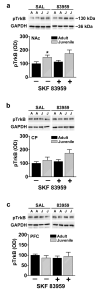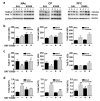Enhanced brain-derived neurotrophic factor signaling in the nucleus accumbens of juvenile rats
- PMID: 24021607
- PMCID: PMC4243163
- DOI: 10.1159/000351026
Enhanced brain-derived neurotrophic factor signaling in the nucleus accumbens of juvenile rats
Abstract
Brain-derived neurotrophic factor (BDNF) signaling through its receptor, tropomyosin receptor kinase B (TrkB), plays a critical role in neural plasticity and its dysregulation in striatum and prefrontal cortex (PFC) has been implicated in the etiology of mental health disorders such schizophrenia and drug addiction. In the present study, we characterized age-dependent differences in BDNF signaling and TrkB expression within the nucleus accumbens (NAc), caudate putamen (CP) and PFC in rats and determined the effects of administration of the dopamine agonist, SKF 83959, which activates the Gq-coupled dopamine receptors, the dopamine D5 receptor and the D1-D2 receptor heteromer. As proBDNF binds with high affinity to the p75 neurotrophin receptor (p75NTR), expression levels of these proteins were also assessed. The present findings showed that juvenile rats (aged 26-28 days) exhibited significantly elevated basal BDNF expression and activation of full-length TrkB (TrkBfull) in NAc compared to their adult counterparts, as evidenced by increased TrkBfull phosphorylation. These changes were concomitant with an increase in the relative expression of TrkBfull compared to the truncated isoform, TrkB.T1, in NAc and CP. Conversely, in PFC the basal expression of BDNF in juvenile rats was significantly lower than in adult rats with an elevated relative expression of TrkBfull. Acute administration of SKF 83959 to juvenile rats abolished the age-dependent differences in BDNF expression in NAc and PFC, and in the relative expression of TrkBfull in NAc and CP. Together these findings indicate that the expression and/or signaling of BDNF and TrkB in striatum and PFC of juvenile rats is fundamentally different from that of adult rats, a finding that may have implications in neuropsychiatric disorders that exhibit age-dependent susceptibility such as schizophrenia and drug addiction.
Copyright © 2013 S. Karger AG, Basel.
Figures





Similar articles
-
Sex difference in dopamine D1-D2 receptor complex expression and signaling affects depression- and anxiety-like behaviors.Biol Sex Differ. 2020 Feb 22;11(1):8. doi: 10.1186/s13293-020-00285-9. Biol Sex Differ. 2020. PMID: 32087746 Free PMC article.
-
A physiological role for the dopamine D5 receptor as a regulator of BDNF and Akt signalling in rodent prefrontal cortex.Int J Neuropsychopharmacol. 2013 Mar;16(2):477-83. doi: 10.1017/S1461145712000685. Epub 2012 Jul 25. Int J Neuropsychopharmacol. 2013. PMID: 22827965 Free PMC article.
-
Knockdown of tropomyosin-related kinase B receptor expression in the nucleus accumbens shell prevents intermittent social defeat stress-induced cross-sensitization to amphetamine in rats.Eur J Neurosci. 2014 Mar;39(6):1009-1017. doi: 10.1111/ejn.12464. Epub 2013 Dec 19. Eur J Neurosci. 2014. PMID: 24354924
-
Dysregulation of proBDNF/p75NTR and BDNF/TrkB Signaling in Acute Ischemic Stroke: Different Sides of the Same Coins.Brain Res Bull. 2025 Jun 15;226:111338. doi: 10.1016/j.brainresbull.2025.111338. Epub 2025 Apr 8. Brain Res Bull. 2025. PMID: 40209946 Review.
-
Circadian control of p75 neurotrophin receptor leads to alternate activation of Nrf2 and c-Rel to reset energy metabolism in astrocytes via brain-derived neurotrophic factor.Free Radic Biol Med. 2018 May 1;119:34-44. doi: 10.1016/j.freeradbiomed.2018.01.026. Epub 2018 Jan 31. Free Radic Biol Med. 2018. PMID: 29374533 Review.
Cited by
-
Neuroplasticity and Multilevel System of Connections Determine the Integrative Role of Nucleus Accumbens in the Brain Reward System.Int J Mol Sci. 2021 Sep 10;22(18):9806. doi: 10.3390/ijms22189806. Int J Mol Sci. 2021. PMID: 34575969 Free PMC article. Review.
-
Maternal separation produces alterations of forebrain brain-derived neurotrophic factor expression in differently aged rats.Front Mol Neurosci. 2015 Sep 1;8:49. doi: 10.3389/fnmol.2015.00049. eCollection 2015. Front Mol Neurosci. 2015. PMID: 26388728 Free PMC article.
References
-
- Costello EJ, Mustillo S, Erkanli A, Keeler G, Angold A. Prevalence and development of psychiatric disorders in childhood and adolescence. Arch Gen Psychiatry. 2003;60:837–844. - PubMed
-
- Patton GC, Viner R. Pubertal transitions in health. Lancet. 2007;369:1130–1139. - PubMed
-
- Shahbazi M, Moffett AM, Williams BF, Frantz KJ. Age- and sex-dependent amphetamine self-administration in rats. Psychopharmacology (Berl) 2008;196:71–81. - PubMed
Publication types
MeSH terms
Substances
Grants and funding
LinkOut - more resources
Full Text Sources
Other Literature Sources
Research Materials
Miscellaneous

